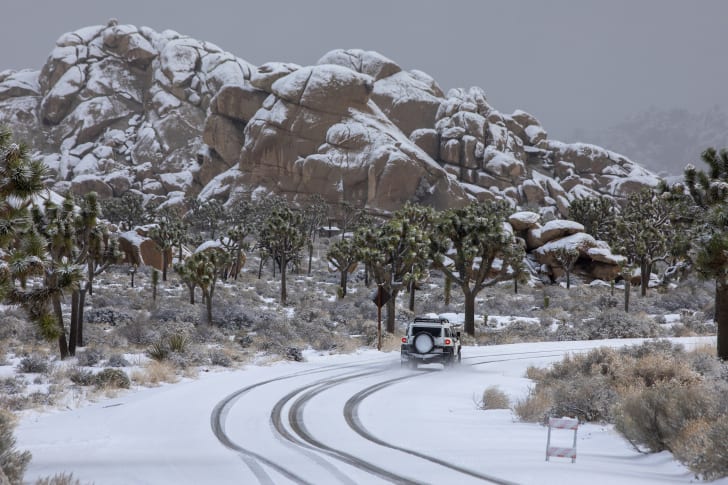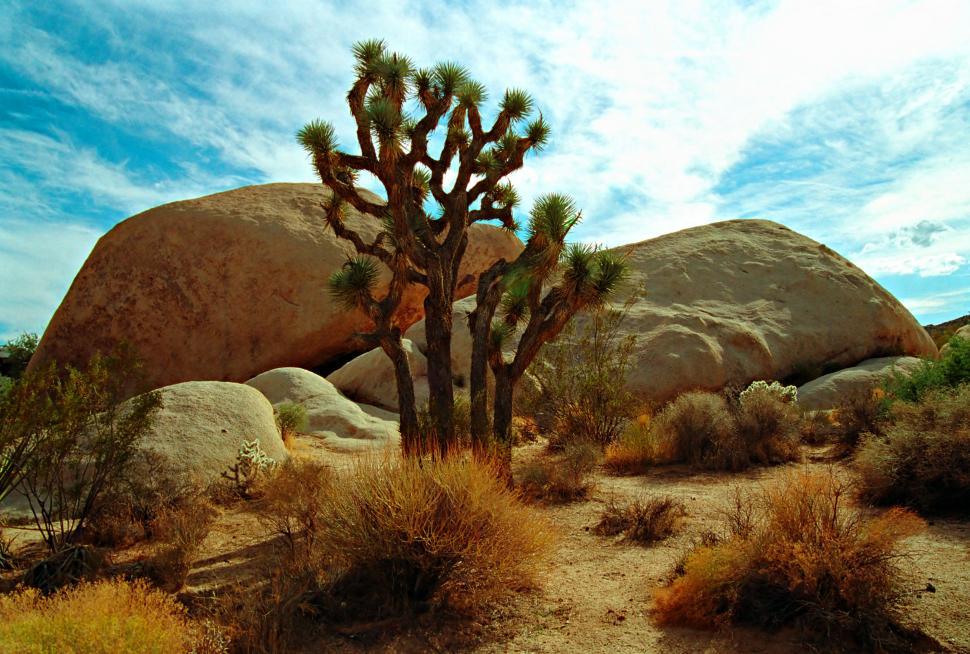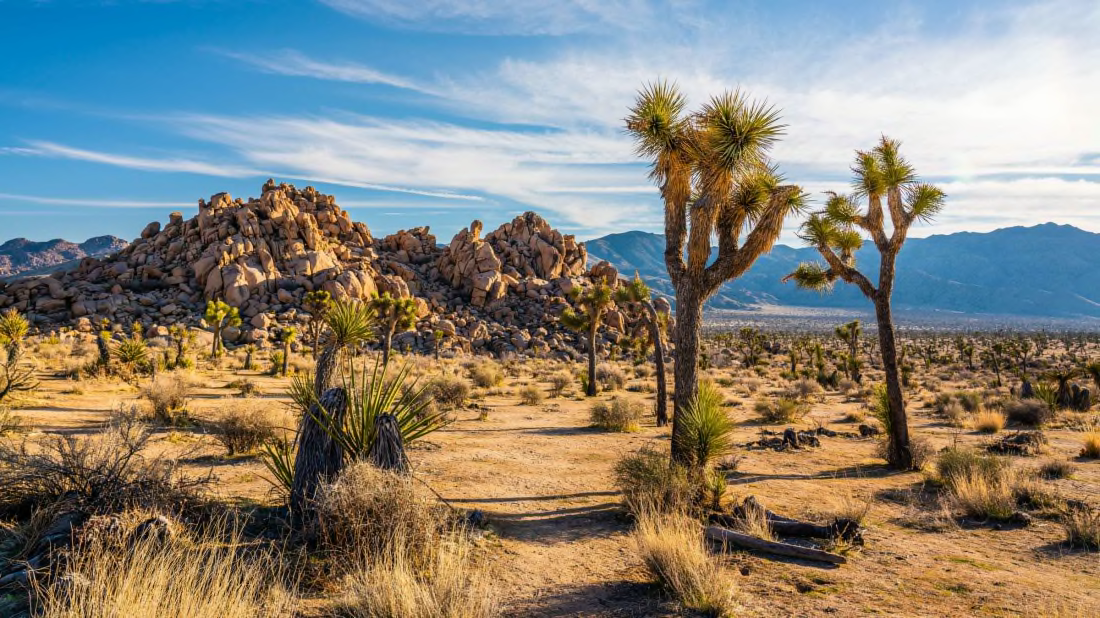Joshua Tree National Park has always had a glamorous cachet—it is, after all, just two hours away from Los Angeles, so it's no surprise the park has a fascinating history filled with Hollywood-style drama.
1. Joshua Tree National Park includes two deserts.
Many people don’t realize Joshua Tree National Park is actually composed of two distinct deserts. The southern tip of the Mojave Desert makes up its western edge and the Colorado Desert covers its eastern and southern areas. These deserts have different elevations, and as a result, different ecosystems. The Colorado Desert’s gentle slopes receive more annual rainfall and are home to desert lavender, desert agave, and colorful ocotillo plants [PDF].
The Joshua trees for which the park is named are more prevalent in the higher elevations on the Mojave side. The densest growth of Joshua trees in the world is found on the 1500-foot Cima Dome. The western end of the park even ascends into the 4000-foot San Bernardino Mountains, home of quaking aspen, California juniper, and Douglas pine trees.
2. Despite its geological age, as a national park, Joshua Tree is a Millennial.
Joshua Tree is one of the youngest national parks in the country—it received that designation in October 1994. Joshua Tree now encompasses 800,000 acres, an area roughly the same size as Rhode Island [PDF].
It’s also one of the most popular national parks, as it’s a mere two-hour drive from Los Angeles. Its popularity has been a mixed blessing: Joshua Tree has seen an average of 3 million visitors per year in the past few years, though its infrastructure was only built for 1 million annually.
This leads to long waits at the entrance gates and crowded campgrounds. Much of the park isn't reachable by road, causing overrun trails in the easier-to-access areas.
3. Joshua trees are not actually trees.

The Joshua tree is a member of the Yucca genus, a genus of usually stemless succulents. They can grow up to 70 feet tall, though they can take up to half a century to reach their full size. The Joshua trees live for around 150 years, and it takes decades before their distinctive branches even begin to form.
Because they store moisture in their roots, Joshua trees are referred to as the “great canteen of the desert.” Squirrels and jackrabbits find water by chewing on the trees during extreme drought, which in turn allows hawks and coyotes to find food.
The shrub is only native to northwest Mexico and the American Southwest. Though there are still nearly a million currently growing throughout the Mojave Desert, like many other species, climate change has limited their range. By the end of the century, environmentalists predict 80 percent of Joshua trees will be wiped out.
4. Joshua trees were given their distinctive name by Mormon settlers.
The Cahuilla people call Joshua trees humwichawa. Traditionally, they used the hardy plant’s leaves and seeds for baskets, sandals, and food, and even carved out its branches for use as containers.
When Mormon settlers first arrived in the area in the 19th century, legend has it that the distinctive trees reminded them of the Old Testament story of Joshua, the leader of the Israelites who held his arms up to heaven in a prayer to God to lead them across Canaan, hence the plant’s current name.
5. Joshua Tree National Park has a long human history.
Mormons may have given the national park its current moniker, but people are believed to have lived in the area for thousands of years. The rocky landscape provided shelter, as well as springs and vegetation for food. The park still contains artifacts from the Mojave, Serrano, Chemeheuvi, and Cahuilla tribes—including petroglyphs carved into many of the rock formations. By the 1800s, cattlemen, miners, and homesteaders had begun to appear on the land.
6. It snows in Joshua Tree National Park.

The park is known for its heat: The average high in the summer months is a roasting 100° F. But like many deserts, it can become quite cold as well, and snow in the higher elevations is not unheard of. Temperatures have dropped below freezing in the winter—once reaching a record low of 10° F in 1990 —and the park gets a dusting of snow about every year. It’s actually too cold for most cacti to grow there.
In February 2021, the park saw a snowfall like it hadn’t seen in over a decade. The snow reached not only the usual higher elevations, but also the valley floor. The Joshua trees apparently love precipitation in any form, but the snow and ice typically disappear as quickly as they arrive.
7. The cover of U2’s famous album was not shot at Joshua Tree National Park ...
The black and white panoramic photograph on the sleeve of U2’s blockbuster 1987 album The Joshua Tree wasn't shot in the national park, though the image on the inside cover is in fact of one of the trees. The famous cover was actually shot 200 miles away in Darwin, California.
On a bus trip around the Mojave Desert during the first day of shooting, lead singer Bono learned of the biblical origin of the name Joshua tree and decided to make it the title of the band’s album. The next day, the cover photo was taken in under half an hour by the now-famous lone Joshua tree in Darwin.
In 2011, a Dutch music venue manager died in Joshua Tree National Park; some believed he was searching for the spot used in U2’s album cover, after he told colleagues he wanted to visit it.
8. ... The Eagles, however, did shoot an album cover at Joshua Tree National Park.
Joshua Tree National Park has a long history of inspiring artists, especially musicians. The Eagles’ self-titled 1972 debut album features a scenic sunset at the park. The photoshoot occurred during an overnight camping trip with the band and photographer Henry Diltz.
As Don Henley recalls in the documentary The History of the Eagles, Part One, “We had a bag of peyote buttons, a bunch of trail mix, some tequila, a bunch of water, and some blankets. And the seven of us set out for Joshua Tree.”
In the decades since, the park has continued to feature widely in music, voted by USA Today as one of the top musical attractions in the world in 2015. Joshua Tree National Park also serves as a backdrop in the music videos for Selena’s “Amor Prohibido,” Missy Elliott’s “Lose Control,” Ariana Grande’s “Into You,” and Walk the Moon’s “One Foot.”
9. Joshua Tree National Park is the site of music history’s most famous cremation.
One of the park’s more bizarre music connections surrounds the funeral of country-rock pioneer Gram Parsons. Parsons was briefly a member of the Byrds, introduced the Rolling Stones to country music, and discovered Emmylou Harris. He visited the park in September 1973 and died of an overdose in the nearby Joshua Tree Inn on September 19.
During the trip, his road manager, Phil Kaufman, claimed Parsons spoke of his desire to be cremated upon his death and have his ashes scattered in Joshua Tree. To fulfill the musician’s final wishes, Kaufman and his friend posed as mortuary workers to intercept Parsons’s body at the airport, stopped at a gas station for gasoline canisters, and drove to Joshua Tree National Park’s Cap Rock formation, where they doused the body in gasoline and set it on fire before being caught.
There was no law against stealing a corpse, so instead the two men were only charged with misdemeanor theft for stealing the coffin, and were forced to pay several small fines. The motel where Parsons died is still in operation and his room remains its most popular. Makeshift memorials pop up on Cap Rock, but Joshua Tree doesn't officially recognize Parsons's link to the park.
10. Some believe Joshua Tree National Park is a UFO hotspot.

Area 51 isn't the only desert locale with an extraterrestrial reputation. Joshua Tree National Park has also been dubbed a UFO hotspot. Ufologist Dr. Steven Greer hosts “Contact in the Desert,” the world’s largest UFO conference, for three days every June in the park. The conference presents on alleged archaeological evidence of aliens and how to contact extraterrestrial life. UFO enthusiasts can even stay in a Futuro house within the park.
CREDIT https://www.mentalfloss.com/article/59638/why-do-we-drive-parkways-and-park-driveways?utm_content=infinitescroll2



Comments
Leave a comment